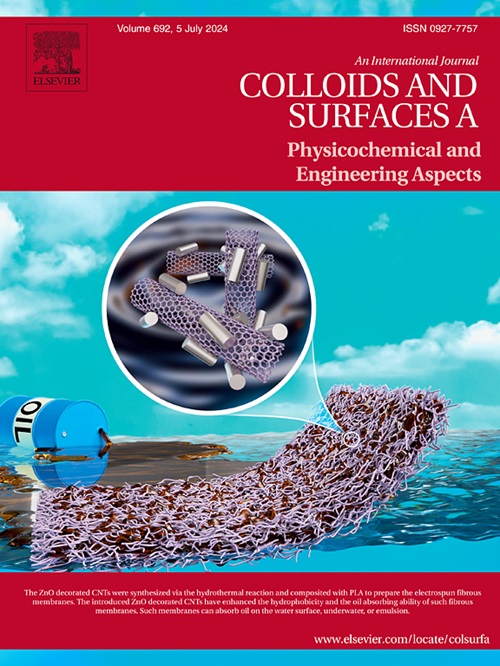Cotton fabric coated with graphene oxide nanosheets and CuO nanoparticles as a “dip catalyst” for the photocatalytic degradation of dyes
IF 4.9
2区 化学
Q2 CHEMISTRY, PHYSICAL
Colloids and Surfaces A: Physicochemical and Engineering Aspects
Pub Date : 2024-10-28
DOI:10.1016/j.colsurfa.2024.135670
引用次数: 0
Abstract
This research focuses on the immobilization in-situ of CuO nanoparticles on graphene oxide nanosheets modified cotton fabric (CuO/GO@CF) for the photodegradation, of organic dyes. The process involves coating the fabrics (CF) with graphene oxide (GO) nanosheets through sonication.
The produced CuO, GO@CF, and CuO/GO@CF have been characterized utilizing various physicochemical methods, such as X-ray diffraction (XRD), Fourrier Transformed Infra-Red (FTIR), trans mission electron microscopy (TEM), scanning electron microscopy (SEM), X-ray photoelectron spectroscopy (XPS), and Thermogravimetric analysis (TGA).
The catalytic activity of the nanocomposite was assessed by methylene blue (MB) oxidation. Additionally, a detailed analysis was conducted to determine how various parameters, including catalyst surface, pH, MB concentration and CuO loading (%), affected the degradation efficiency. The results showed that the 10 %CuO/5 %GO@CF with a surface of 4 cm2 (2 × 2 cm) exhibited the highest catalytic activity, achieving a MB removal efficiency of 82 % in 90 min. Additionally, after successive reaction cycles, the synthesized composite showed excellent stability and no appreciable drop-in catalytic activity. Moreover, it was shown that the primary reactive oxidative species (ROSs) in charge of the extremely effective MB breakdown were HO.. Lastly, catalyst stability and recyclability showed that CuO/GO@CF might be used as a substitute photocatalyst for environmental cleanup and dye degradation. This synthetized composite can be easily added to and removed from the reaction solution while maintaining high catalytic performance in the removal of dyes and it could be beneficial in avoiding problems related to powder separation.
将涂有氧化石墨烯纳米片和氧化铜纳米颗粒的棉织物作为光催化降解染料的 "浸渍催化剂"
本研究的重点是将 CuO 纳米粒子原位固定在氧化石墨烯纳米片改性棉织物(CuO/GO@CF)上,用于有机染料的光降解。该工艺包括通过超声处理在织物(CF)上涂覆氧化石墨烯(GO)纳米片。利用各种物理化学方法,如 X 射线衍射 (XRD)、傅立叶变换红外 (FTIR)、透射电子显微镜 (TEM)、扫描电子显微镜 (SEM)、X 射线光电子能谱 (XPS) 和热重分析 (TGA),对所制备的 CuO、GO@CF 和 CuO/GO@CF 进行了表征。此外,还进行了详细分析,以确定催化剂表面、pH 值、甲基溴浓度和氧化铜负载量(%)等各种参数如何影响降解效率。结果表明,表面积为 4 cm2(2 × 2 cm)的 10 %CuO/5 %GO@CF 的催化活性最高,90 分钟内的甲基溴去除率达到 82%。此外,在连续反应循环后,合成的复合材料表现出优异的稳定性,催化活性没有明显下降。此外,研究还表明,负责高效甲基溴分解的主要活性氧化物(ROS)是 HO。最后,催化剂的稳定性和可回收性表明,CuO/GO@CF 可用作环境净化和染料降解的替代光催化剂。这种合成的复合材料可以很容易地添加到反应溶液中,也可以很容易地从反应溶液中移除,同时在去除染料方面保持很高的催化性能,而且还可以避免与粉末分离有关的问题。
本文章由计算机程序翻译,如有差异,请以英文原文为准。
求助全文
约1分钟内获得全文
求助全文
来源期刊
CiteScore
8.70
自引率
9.60%
发文量
2421
审稿时长
56 days
期刊介绍:
Colloids and Surfaces A: Physicochemical and Engineering Aspects is an international journal devoted to the science underlying applications of colloids and interfacial phenomena.
The journal aims at publishing high quality research papers featuring new materials or new insights into the role of colloid and interface science in (for example) food, energy, minerals processing, pharmaceuticals or the environment.

 求助内容:
求助内容: 应助结果提醒方式:
应助结果提醒方式:


